
334. $200
Waterbury “Rambler” carriage clock, ca. 1906. This 5-inch carriage clock has been replated
in a rich gold finish, looking much like a factory-new clock would. There are three beveled glasses, a signed porcelain dial,
and a bell on the bottom to strike the hours and half-hour. The handle is not correct but looks fine. The clock is running,
fast, and the strike spring is broken or not attached so it doesn’t sound the hours. There is a repeater button that restrikes
the hours, useful if you keep this clock on your nightstand (and you fix the strike spring). There is a list of patent dates
on the rear door, the most recent being 1891. You rarely find these clocks in replated (or good original) condition.
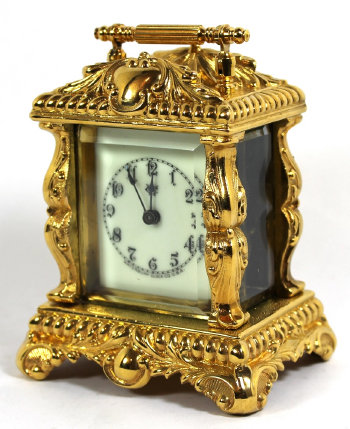
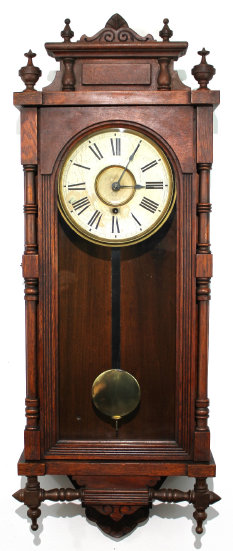
335. $275
Ansonia “Queen Elizabeth”, 1901. This is the later version of this clock, with the 1880 version
having a different crest and base. It is a 37-inch oak case with a dark finish in need of renewal. The glass is old as
is the signed paper dial, which also could stand to be renewed; we can do that for you for $25. The hands are new, the pendulum
bob old and with a spot of oxidation near the pendulum stick. It holds an 8-day time-only signed movement that is running and
keeping time. Nice label on the back. Several recent sales on eBay, averaging $330 over the last several years.
336. $175
Ansonia “Surrey”, ca. 1910. Ansonia put out a number of metal case clocks in the early 1900’s
with a “Colonial Brass Finish” and all of them have suffered the same fate over the years, with the brass finish being worn off by
excessive polishing. This one is in better shape than most, but still has its issues. You can see that it has been buffed
to a bright shine and can also see spots where the copper undercoating is showing through. There is some fine pitting on the
sides, and some spots where there is still tarnish. Shiny clocks are next to impossible to photograph and all the imperfections
seem to be magnified, so please consider that this clock looks great from a more reasonable distance. There are some scrapes
and wear to the dial, and some of the numbers have been touched up. It has an 8-day half-hour strike movement that is running
and keeping time. Sale prices for these brass clocks vary with the quality of the finish, ranging from $100 to $250.
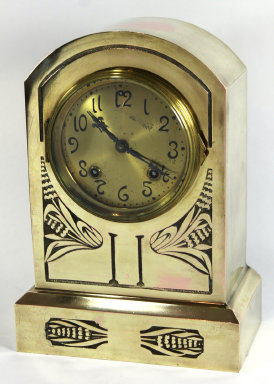
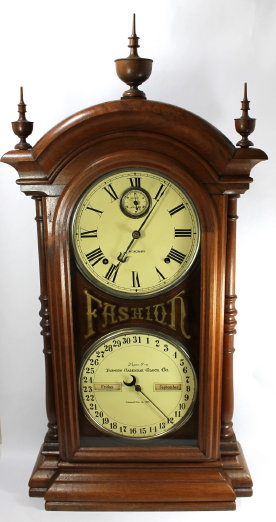
337. $1500
Southern Calendar Clock Co. “Fashion No. 5”, 1875-1889. The No. 5 has the long-drop pendulum
and recessed seconds bit dial. The case is walnut, nicely refinished, and the dials have been repainted and calendar rollers
repapered. The finials are replacements. The glass is new and the Fashion lettering are decals. The hands are correct
as is the signed Seth Thomas movement, the calendar movement, and the cathedral gong. The pendulum bob is normally nickel with
a damascened pattern but this one is brass. Not sure that matters, as it is not visible. The clock is running and the
calendar is advancing. Fashion No. 5’s are pretty uncommon; Schmitt’s sold one in 2014 for $1600 and Harris sold one in the
same year for $2500. We sold this clock in 2015 for $2075.
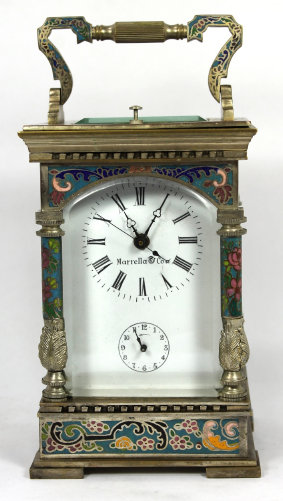

339. $300
Brass carriage clock with filigree trim, ca. 1900. This standard size carriage clock
stands 6 inches high with the handle up and has a 2-inch porcelain dial with a filigree dial insert. There is a bright gold
front behind a filigree mask, with filigree side panels all behind beveled glasses. The glass in the door shows some chipping
in the corners, and there is some dried brass polish behind the glasses on the sides that would clean up easily if you’re willing
to take it apart. There is no signature anywhere I can see, and no country of manufacture indicated. The key that comes
with it states “Made in England”. It is a time-only 8-day movement, and is running and keeping time. Very nice, I think. An identical carriage clock sold at Schmitt’s in 2004 for $500.
338. $200
French Chinese champlevé repeater carriage clock, ca. 1970. This multicolored enamel
champlevé carriage is 8 inches tall with the handle up. The case is silver- or nickel-plated and most of the plating is still
present, although it shows areas of tarnish that would no doubt clean up with Nevr Dull wadding polish or Simichrome. It has
a white enamel dial signed “Marrella & Co.” with trefoil hands, a seconds hand, and an alarm dial. There are four beveled,
arched glasses and a beveled glass on top over the silver platform lever escapement with jeweled pallets. The clock is running,
fast, but the strike is out of sequence and I don’t know how to adjust that. There are way too many armatures and gears in the
back to sort out. I assume it is an eight-day movement. The handle is also lost from the back door and so it’s best not
to close tightly. It’s not signed anywhere, and the country of origin is not indicated, but Bob Crowder tells us it is Chinese. It’s really quite nice and only needs a bit of polish to really make it sparkle. Two keys are included. A similar clock
in gold can be seen on page 180 of Derek Roberts’ book “Carriage and other traveling clocks”. $200-$300.